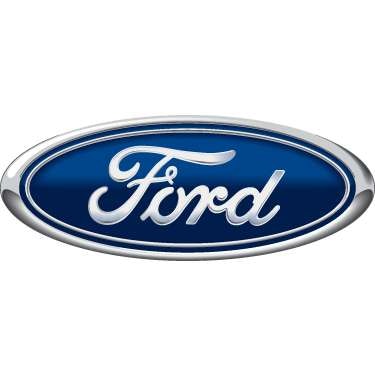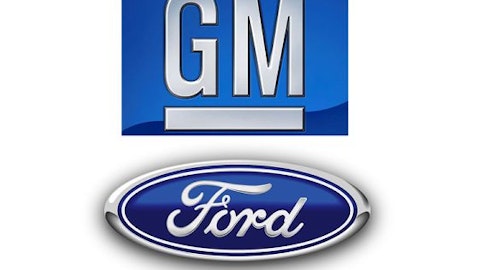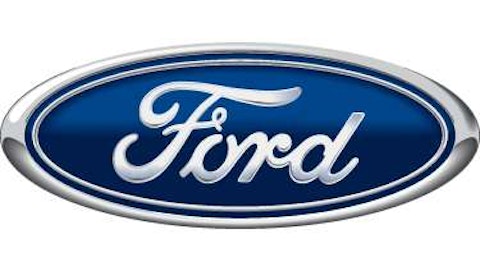Despite Europe, where sales remain flat, the automotive sector is leaving its worst times behind and showing signs of slight recovery. The rebound in the U.S. construction industry is boosting demand for vehicles, mostly pickup trucks. Fifteen million cars and light trucks will be sold this year in the country, especially favoring the big three domestic brands. Companies unfortunately cannot focus on America alone, and have to expand in the fast-growing emerging markets, where competition is growing.
Let’s see how three car manufacturers are performing.
Ford Motor Company (NYSE:F) looks east
Ford Motor Company (NYSE:F) is a producer of cars and trucks, operating in two sectors: Automotive and Financial Services.
The company’s Q1 positive results were driven by a strong performance in North America and Asia Pacific Africa. Earnings of $0.41 per share have risen 5.1% year over year. Revenues grew 10.5% as well. Management expects a growth in the company’s U.S. market share for this year, maintaining pre-tax operating profit level, and a decline in operating margins to 10%.
Ford Motor Company (NYSE:F) has an ambitious expansion plan in which China and India play a major role. The company expects Asia to account for 70% of its global growth in this decade. Ford Motor Company (NYSE:F) poured $500 million in both countries since 2009, with a strong focus on small cars, which now account for 48% of total sales and is expected to increase.
Its product transformation plan “One Ford,” with the mission to produce common vehicle models and shift from trucks to small cars, is having a positive impact. Another key objective is to concentrate production on fewer core platforms. The company will also launch its Lincoln lineup in China in 2014 to exploit the booming luxury market in the country.
Nonetheless, higher structural costs and the global economic weakness are becoming a concern. The high relative costs of replacing older models and launching new ones puts pressure on cash flow. Plus, operating margins will decrease in North America due to higher sales of less-profitable small cars.
European exposure for GM
General Motors Company (NYSE:GM) is reviving from its ashes.
Despite a 3.6% rise in retail unit sales, the company’s profits for the quarter fell 28%, with EPS of $0.67. With the exception of Europe, all geographic operations generated lower earnings. Revenues dropped 2.4% reaching $36.9 billion. Management expects modest growth in sales this year due to bad performance in Europe. That will come despite improvements in the U.S. and China.
General Motors Company (NYSE:GM) has benefited from its focus on the developing markets, particularly Brazil, China and India, and it expects better results from its global expansion plan. Four new plants will be built in China to reach annual production of 5 million vehicles and triple exports to 300,000 units.
The company is No. 2 in terms of sales after Toyota, with 9.29 million vehicles sold in 2012. It plans to invest $8 billion annually in new-vehicle development and to upgrade 70% of its global lineups. However, the company’s high exposure to Europe and the global sluggish economy makes me remain cautious about the stock. General Motors Company (NYSE:GM) Europe’s revenues fell 17.6% in 2012 and 8.3% this quarter. The market is expected to shrink 4%, so I doubt we will receive good news coming from the old continent in the short term.
Toyota is still in the driver’s seat
Japan-based Toyota Motor Corporation (ADR) (NYSE:TM) is still the world-wide leader.
The company’s earnings of $10.22 billion increased more than three times, throwing an EPS of $3.23 per share. Toyota Motor Corporation (ADR) (NYSE:TM) is benefiting from cost-reduction initiatives and its strength in the environmental-friendly market.
The company is No. 1 in terms of sales, with 9.75 million vehicles sold worldwide in 2012. As part of its global expansion, Toyota Motor Corporation (ADR) (NYSE:TM) plans to offer eight new compact vehicle models in the emerging markets by 2015 and drive 50% of global sales from these markets. Brazil, China and India are key.
However, continued safety recalls are damaging the brand image and increasing costs, which added more than $1.1 billion between settlements and government fines. The company is experiencing problems in the Chinese and European markets as well. Japan’s conflict with China over islands in the East China Sea is affecting sales in the country, one of the company’s largest markets. In addition, the 10% production Japanese output decrease Toyota Motor Corporation (ADR) (NYSE:TM) will have to face as a product of Fukushima-related power shortages will offset profits coming from a weaker yen.
Bottom line
Ford’s increase in U.S. market share and ambitious plans in Asia are encouraging, but the high costs that the company is assuming could bring problems if future models do not sell well. I would buy Ford Motor Company (NYSE:F) only for short-term purposes and sell if operations and profitability do not improve.
Despite some improvements in other regions, General Motors Company (NYSE:GM)’ performance in Europe is a drag and I do not foresee an important correction coming anytime soon. I would sell the stock.
Toyota Motor Corporation (ADR) (NYSE:TM)’s position in the high-perspective hybrid markets and its expansion in the developing markets make it an interesting option for the long term. I would buy for the short term and keep an eye on its performance primarily in Asia.
The article The Automotive Industry Is Coming Back originally appeared on Fool.com and is written by Vanina Egea.
Vanina Egea has no position in any stocks mentioned. The Motley Fool recommends Ford and General Motors. The Motley Fool owns shares of Ford.
Copyright © 1995 – 2013 The Motley Fool, LLC. All rights reserved. The Motley Fool has a disclosure policy.



